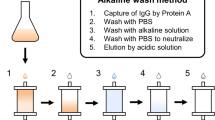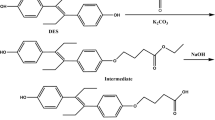Abstract
THE isolation of precipitating antibodies in a purified form has been the subject of several investigations during the past few years. The property of the specific combination of antibodies with their homologous antigens has been exploited for this purpose. In principle, a general procedure for the isolation of antibodies would involve the following steps: (1) formation of insoluble antibody–antigen complexes, (2) dissociation of these complexes, and (3) separation of the purified antibodies from the antigen(s). Obviously, the last step would be facilitated if the antigen were insoluble or could be made insoluble by coupling it via stable covalent chemical bonds to a supporting medium. For example, in previous investigations protein antigens were coupled to fibrinogen1, ion-exchange resins2 and cellulose3. Since these supporting media were endowed with ion-exchange properties, it is conceivable that serum proteins may be bound to them non-specifically. In order to avoid or at least to minimize non-specific absorption of serum proteins, in the present study, protein antigens were coupled through stable azo bonds to a non-polar polystyrene (Dow ‘Styron PS-2’ obtained through the courtesy of the Physical Laboratory, Dow Chemical Co., Midland, Michigan) framework. For this purpose polystyrene was nitrated4. The ensuing polynitro polystyrene was then reduced to polyamino polystyrene4,5 and the latter compound diazotized. The soluble protein antigens were then coupled to the polydiazotized polystyrene at pH 7.5. The resulting insoluble Styron–antigen conjugates are dark brown precipitates. At the beginning of the study we were not aware that a somewhat similar procedure had been used for coupling proteins to polystyrene6,7.
This is a preview of subscription content, access via your institution
Access options
Subscribe to this journal
Receive 51 print issues and online access
$199.00 per year
only $3.90 per issue
Buy this article
- Purchase on Springer Link
- Instant access to full article PDF
Prices may be subject to local taxes which are calculated during checkout
Similar content being viewed by others
References
Karush, F., and Marks, R., J. Immunol., 78, 296 (1957).
Isliker, H. C., Ann. N.Y. Acad. Sci., 57, 225 (1953).
Campbell, D. H., Luescher, E., and Lerman, L. S., Proc. U.S. Nat. Acad Sci., 37, 575 (1951).
Bachman, G. B., Hellman, H., Robinson, K. R., Finholt, R. W., Kahler, E. J., Filar, L. J., Heisey, L. V., Lewis, L. L., and Micucci, D. D., J. Org. Chem., 12, 108 (1947).
Joshi, G. G., and Shah, N. M., Current Sci., 18, 73 (1949).
Grubhofer, N., and Schleith, L., Hoppe-Seyler's Z. Physiolog. Chem., 297, 108 (1954).
Manecke, G., and Gillert, K. E., Naturwiss., 42, 212 (1955).
Gyenes, L., Rose, B., and Sehon, A. H., Canad. J. Biochem. and Physiol. (to be submitted).
Author information
Authors and Affiliations
Rights and permissions
About this article
Cite this article
GYENES, L., BOSE, B. & SEHON, A. Isolation of Antibodies on Antigen–Polystyrene Conjugates. Nature 181, 1465–1466 (1958). https://doi.org/10.1038/1811465a0
Issue Date:
DOI: https://doi.org/10.1038/1811465a0
This article is cited by
-
Untersuchungen über die Biosynthese und über den serologischen Nachweis des Ribonucleoproteid-Antigens von Influenzaviren
Zeitschrift für Medizinische Mikrobiologie und Immunologie (1971)
-
Preparation of Polyacrylamide Gels which contain Protein and their Use as High Capacity Immunosorbents
Nature (1969)
-
�ber serologisch wirksame Proteinharze und Enzymharze
Die Naturwissenschaften (1964)
-
Immunochemically Active Cross-linked Polystyrene
Nature (1959)
Comments
By submitting a comment you agree to abide by our Terms and Community Guidelines. If you find something abusive or that does not comply with our terms or guidelines please flag it as inappropriate.



